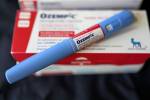Survey ranks Nevada last in US for children’s health care
Once again, Nevada lands at the bottom of a list, this time ranking the best and worst states for children’s health care.
The state finished No. 51 (the study included the District of Columbia) in research by WalletHub, a credit services website. The findings continue a long, depressing tradition for Nevada, which is no stranger to performing poorly in measures of health. However, valley health care professionals say they’re optimistic that medical services for kids are improving in the state, even if it’s happening more slowly than anybody would like.
Tara Phebus, executive director of the Nevada Institute for Children’s Research and Policy, said the general trend shown in the survey is consistent with similar surveys that have been done about children’s health. For example, the Children’s Advocacy Alliance in 2014 gave Nevada a grade of D in evaluating health services to the state’s children.
However, Phebus noted that data used in such national surveys can lag a year or two behind and not reflect more recent improvement.
Rankings also can be colored by other states’ performances. For instance, Phebus said, “even if we make improvements, if other states make improvements, too, we still don’t move up on that list.”
Dr. Jay Fisher, medical director of the pediatric emergency department at Children’s Hospital of Nevada, said the methodology of the WalletHub survey is sound and that it “probably represents our situation pretty accurately.”
Room for improvement
Experts say Nevada’s challenges range from a relative dearth of pediatricians and family care physicians to a transience among residents that can make obtaining regular preventive care for kids a back-burner task.
“Some of it is about infrastructure and catching up to our population growth,” Phebus said.
Fisher said that when he came to Las Vegas in 1992, “I remember scanning through the phone book at the time, and there were more cosmetic surgeons than pediatricians. … And we’ve been playing catch-up ever since.”
Todd Sklamberg, chief executive officer for Sunrise Hospital and Medical Center and Sunrise Children’s Hospital, noted that issues that make caring for kids in Nevada difficult are, to some degree, the same issues that can impede care for adults here.
For example, Nevada has the fewest number of physicians per capita in the United States, he said. “This has posed a significant challenge to our community in having access to care or preventive care.”
“As a result, the emergency rooms in Las Vegas as well as the state serve in many ways as the sole access to care,” he said. “So patients utilize emergency rooms for nonemergent care and to receive care that they’d normally receive in a pediatrician’s office or an internist’s office.
Initiatives — including advances in graduate medical education here and creation of UNLV’s medical school — have helped, he said. “We’re moving in the right direction, but we have a long way to go.”
Other hurdles include lack of health insurance or insufficient health insurance, or an inability to pay for medical care, even as Medicaid and the Affordable Care Act permitted more Americans to obtain coverage.
From small town to large city
Fisher sees the valley’s growth contributing to the lagging statistics. “We’ve gone from a small town in the early ’90s to a major metropolitan area, and in a very rapid amount of time, and I think that’s the main thing,” he said.
Phebus agrees and said such surveys are helpful in highlighting trends and pointing out specific areas that could be targeted for improvement.
“What we need to do as a community is to take a look at the rankings and scores and see where are the places we can make the effort to actually move the needle,” she said.
Contact John Przybys at jprzybys@reviewjournal.com or 702-383-0280. Follow @JJPrzybys on Twitter.
Survey highlights
Here are a few highlights from a WalletHub survey, 2017's Best & Worst States for Children's Health:
Percentage of children aged 0 to 17 in excellent/very good health:
1. South Dakota
2. North Dakota
3. New Hampshire
4. Vermont
5. Missouri
Lowest percentage of children ages 0 to 17 in excellent/very good health:
47. District of Columbia/New Mexico (tie)
49. New Mexico
50. Nevada
51. California
Lowest percentage of uninsured children ages 0 to 17
1. Massachusetts
2. District of Columbia/Vermont (tie)
4. Hawaii
5. Illinois
Highest percentage of uninsured children ages 0 to 17
47. Florida
48. Arizona
49. Texas
50. Alaska
51. Nevada
Lowest percentage of children ages 0 to 17 with unaffordable medical bills:
1. Hawaii
2. District of Columbia/Vermont (tie)
4. South Dakota
5. Pennsylvania
Highest percentage of children ages 0 to 17 with unaffordable medical bills:
47. Florida/Indiana (tie)
49. Arizona
50. Mississippi
51. Nevada
Highest percentage of children ages 1 to 17 with excellent/very good teeth:
1. Vermont
2. New Hampshire
3. Maine/North Dakota (tie)
5.Massachusetts/South Dakota (tie)
Lowest percentage of children ages 1 o 17 with excellent/very good teeth:
47. Texas
48. Arizona
49. California
50. New Mexico
51. Nevada
Highest percentage of children ages 0 to 17 with medical and dental preventive care visits in past year:
1. Vermont
2. Connecticut
3. New Hampshire
4. Massachusetts
5. District of Columbia
Lowest percentage of children ages 0 to 17 with medical and dental preventive care visits in past year:
47. Mississippi
48. South Dakota
49. Alaska
50. Idaho
51. Nevada
By the numbers
Here's how Nevada ranked in the survey:
• 50th: Share of children through age 17 in excellent or very good health
• 51st: Share of uninsured children
• 51st: Share of children with unaffordable medical bills
• 44th: Share of pediatricians and family doctors per capita
• 40th: Share of obese children
• 51st: Share of children with excellent or very good teeth
• 51st: Share of children who have had medical and dental preventive visits in the past year




























